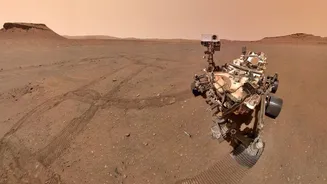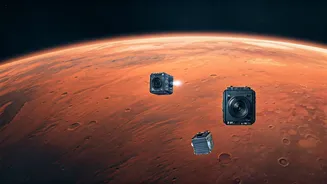Mars' Surface Clues
The surface of Mars acts like a vast historical record, holding details about its evolution over billions of years. Evidence suggests the presence of an
ice age, revealed through geological formations. These 'scratches' and craters, are crucial in understanding the past climate of Mars. Scientists analyze the depth, shape, and distribution of these features. The presence of wind-carved 'megaripples', adds another layer of complexity. These ripples, along with the impact of meteoroids, further contribute to our understanding. Scientists can then piece together how these events reshaped the Martian landscape, leading to a more comprehensive understanding of the Red Planet's history and its environmental conditions.
Ancient Cosmic Impacts
Cosmic impacts have profoundly influenced Mars, shaping its surface and atmosphere, leading to significant geological changes over time. Meteoroid impacts, such as the one that caused a rare avalanche, have left 'barcode' patterns. These formations are visible to orbiters and provide insights into the planet's history. The remnants of ancient cosmic objects might be buried within Mars. The study of impact craters provides data about the age of the Martian surface, the frequency of impacts, and the possible existence of subsurface ice deposits. The effects of these impacts are far-reaching, potentially affecting the climate and distribution of water and other materials on the planet, contributing to the possibility of life preservation.
Frozen Time Capsules
The potential for life on Mars, if it ever existed, is a compelling prospect for the scientific community. One intriguing possibility is the preservation of life in frozen form. Deep beneath the surface, protected from harmful radiation and extreme temperatures, potential organisms might be trapped in icy deposits. The presence of water ice, especially in the polar regions, could act as a time capsule, preserving potential microbial life. If life does exist on Mars, these frozen pockets might contain clues about its origin and evolution. Studying these frozen environments can give us clues about the potential for life's existence.
The Sand Dune Connection
The relationship between AI and the study of Martian sand dunes provides a unique way to understand the planet's history. Sand dunes, shaped by wind over millennia, offer information about past climate conditions. By analyzing the grain size, composition, and distribution of these dunes, researchers can reconstruct ancient environmental changes on Mars. AI can assist by processing vast datasets, identifying patterns, and modeling dune formation and changes. Dry ice, which is present on Mars, may also contribute to the formation of canyons and surface features. Understanding the Martian surface and its features can provide valuable insights into the planet’s geological past, offering clues about the possibility of past or present life.
Volcanic Ice Deposits
Volcanic activity has also played a significant role in shaping the Martian landscape. Volcanic explosions, which occurred long ago, might have contributed to the formation of ice deposits. These deposits, potentially located near the equator, could be a result of the interaction between volcanic gases and the Martian atmosphere. The presence of these ice deposits provides additional evidence about the planet's climate and geological history. The study of these areas can offer details about past volcanic events and their influence on the Martian environment. These details help scientists to better understand the evolution of Mars, and they provide additional clues regarding the presence of water and conditions favorable for supporting life.














